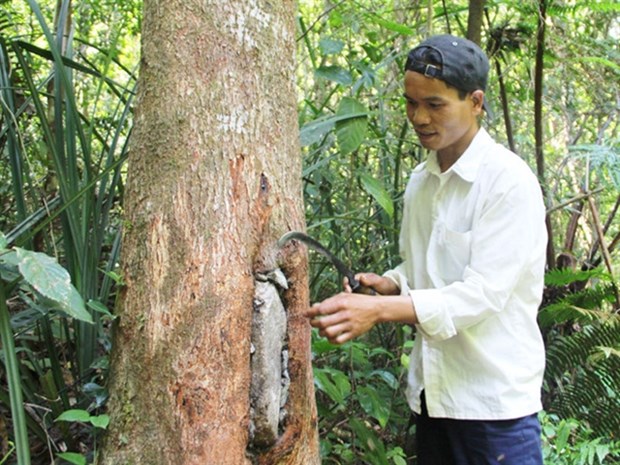 A bee nest box is made by digging a tree trunk and covered with rocks. (Source: VNA)
A bee nest box is made by digging a tree trunk and covered with rocks. (Source: VNA)
Quang
Nam (VNS/VNA) - Ho Van Phuoc is absolutely buzzing about bees.
That's because the Phuoc Loc Commune, Phuoc Son District, Quang Nam
Province resident has hundreds of nest boxes on tree trunks that
provide the main source of income for his family.
Like many other people from the Gie Trieng ethnicity in remote Hamlet 6, Phuoc
started to learn how to make bee nest boxes on tree trunks when he was small,
following his father to the deep forests.
The villagers make new boxes and check old ones in the lunar month of early
February when the weather is warm and enjoy their sweet rewards in May.
They choose big tree trunks with a lot of shade that are located near streams
to make the nest boxes, but pleasant smelling trunks are the best choice.
Each nest box with 40cm deep and 25cm wide is made by digging out a
trunk area one metre from the ground. Villagers cover each box with rocks
and soil, then put one to two finger-size holes on the outside of the box for
bees to enter.
“The tree trunks must be big and hard enough so that the trees will not die
when the trunks are dug. The bigger the box is, the more honey we can collect,”
Ho Van Dong, an elderly villager, told Thanh Nien (Youth)
newspaper.
Ho Van Nho, another old villager, said the key to success is to select rocks to
cover the boxes. Each rock has identical features for bees to mark the path and
call other bees to make nests.
Each rock put in place will stay in the bees’ ‘houses’ for long, up to
dozens of years, and will be kept for use in the next season. It is called the
'rock of sovereignty', Nho said.
If the rocks are replaced by new ones in the next season, bees will leave their
nests, he said.
Living in areas surrounded by forests in Phuoc Son District and close to
Kon Tum Province, people in Hamlet 6 would live in poor conditions without
beekeeping.
All 35 households in the village own at least 20 boxes and some
own hundreds.
Ho Van Men, who owns nearly 200 nest boxes and collects hundreds of litres of
honey a year, said he can cover living expenditures for his five children
thanks to beekeeping.
Another beekeeper, Ho Van Phuoc, owns 30 boxes each of which produces one to
two litres of honey per year. On average, he collects more than 50 litres of
honey annually. Each litre is sold at 400,000 VND to 500,000 VND (17-21 USD).
Bee nest boxes have become valuable properties of villagers as they are the
main source of income for local people. Each owner has identical marks to
distinguish their nest boxes from others.
“We all know bee nest boxes are personal properties and no one touches or
steals boxes not belonging to them,” villager Ho Van Men said.
Bees have a habit of making nests in empty rotten tree trunks. Knowing about
this, many people chop down the trunks to get honey, Phuoc said.
“Gie Trieng people choose a different way. We dig a hole in the trunk to lure
bees,” he said.
Tree trunks on which bee nest boxes are made bring profits to villagers. Beekeepers
here are also nature protectors.
“Losing forests means losing our huge profits,” Phuoc said. That’s why
every villager is aware of the tree trunks’ important role and protects trees.
If spotting any sign of deforestation, villagers report it to the police.
Ho Van Doan, who leads the police team of Phuoc Loc Commune, said this meant deforestation never occurred in the area.- VNS/VNA












